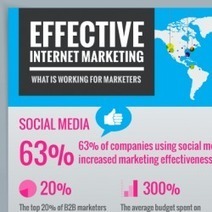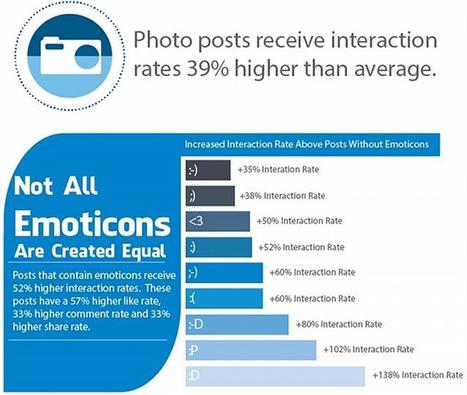This infographic details the prevailing trends for for effective online marketing, with some strong numbers to support each channel. It is interesting to note that 89% of marketers say that they are maintaining or increasing their budgets that focus on these trends. Perhaps this is because inbound marketing costs 61% LESS per lead than traditional, outbound marketing....
Get Started for FREE
Sign up with Facebook Sign up with X
I don't have a Facebook or a X account

 Your new post is loading... Your new post is loading...
 Your new post is loading... Your new post is loading...
Cultural organizations like theater companies, orchestras, and art museums are using the internet, social media, and mobile apps to draw in and engage audiences, provide deeper context, and disseminate their work beyond the stage and the gallery...
A survey of a wide-ranging mix of U.S.-based arts organizations shows that the internet, social media, and mobile connectivity now permeate their operations and have changed the way they stage performances, mount and showcase their exhibits, engage their audiences, sell tickets, and raise funds.
These organizations are even finding that technology has changed the very definition of art: 77% of respondents agree with the statement that the internet has “played a major role in broadening the boundaries of what is considered art.”
“For most of these organizations, technology suffuses their operations and their engagement activities with their communities,” noted Kristen Purcell, research director at the Pew Research Center’s Internet & American Life Project, and a co-author of the report. “They are using the technologies to expand their offerings, grow and diversify their audiences, and bring technology users into the act of creating art itself.”
Jeff Domansky's insight:
If you're in a nonprofit organization or nonprofit PR, the full Pew Internet report is valuable reading.
Efforts to promote social profiles, pages, sharing and engagement are meaningless unless they support a path to conversion and help the bottom line. Here’s how Google Analytics Social Reports can help easily quantify your social media endeavors. Via Pekka Puhakka
Jeff Domansky's insight:
Very practical, useful guide to simple social media measurement. A good intro for beginners and a good reminder for the more experienced. |
Social media will be the most important technology channel used by companies to engage with their customers within three to five years, according to a survey of 1,700 CEOs from around the world conducted by IBM. Currently just 16% of companies use social media as their primary means of interacting with customers, but that proportion will rise to 57% three to five years from now. That increase will put social media ahead of Web sites, call centers, and traditional media. Over the same time period, CEOs see Web site utilization increasing from 47% to 55%, while call center utilization will drop from 40% to 31%, and utilization of traditional media will plunge from 39% to 15%. The only channel outranking social media is face-to-face and sales representatives, although this too will drop from 80% today to 67% three to five years from now....
Jeff Domansky's insight:
Ironic. Research shows that CEOs don't use social media themselves. But the trend to "social business" is unstoppable.
Take some of the guesswork out of your social media efforts with an infographic that reveals surprising data about Facebook.
Lynchpin SEO compiled statistics on the types of posts that garnered the most comments, shares, and “likes,” for more than 1,500 brand pages on Facebook.
Jeff Domansky's insight:
Even the emoticon you use has an impact according to the research featured on this full infographic ;D
So, when is the best time to post? And is it the same for every social network?
RadiumOne’s Po.st examined the social sharing data from more than 10,000 publishers, reaching four main conclusions: 1. There are two peak sharing times during the day – 10 a.m. through noon and 8 p.m. through 10 p.m. 2. If you’re looking for clicks, the worst time to share an article is between 9 a.m. and 11 a.m. 3. Sharing and clickbacks remain consistent from 1 p.m. to 6 p.m. 4. The hours between noon and 2 p.m. see the most shares with the highest clickback rates The study also revealed a disconnect between the best times to post to each social network, which are as follows: Twitter: 1 p.m. Facebook: 5 p.m. Pinterest: 11 p.m. Google+: 10 a.m....
Jeff Domansky's insight:
"Best time to..." social media research studies are always fun and great for debate over drinks. |








![When Is The Best Time To Post To Twitter, Facebook, Pinterest And Google+? [STUDY] - AllTwitter | Public Relations & Social Marketing Insight | Scoop.it](https://img.scoop.it/BKBt7C4ZDRi01DqSSlSMZjl72eJkfbmt4t8yenImKBVvK0kTmF0xjctABnaLJIm9)





Such great "sell the C level" stats here I hardly know where to begin. My favorite stat from this excellent Visual.ly Infographic is companies with 51 blog posts ore more get 77% more inbound leads. Think content marketing isn't important? Let me know how that Luddite thing works out for you. Be sure to send a postcard (lol).